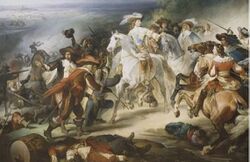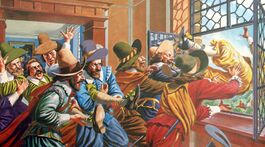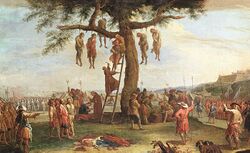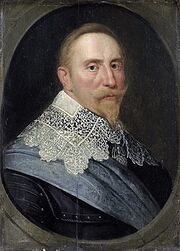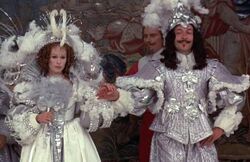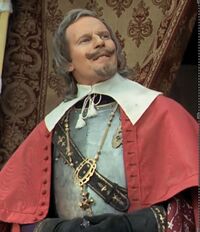Thirty Years' War
“Thirty years? Sounds like a marriage sentence.”
The Thirty Years' War was a European conflict that started in 1618 when three men were thrown out of a Prague window, and officially ended in 1648 in Münster, Germany with a game of indoor tennis. Though described as the Thirty Years' War, hostilities ended after a mere 29 years, 11 months, 3 weeks, and 1 day, though the signing ceremony to make it official was delayed to October to leave no doubt. All the same, the term is more accurate than the Hundred Years' War, which lasted 116 years, 4 months, 3 weeks and 4 days (ending at around half past five, according to a sundial). But the 17th century was the new age of clocks, with wars named accurately, long before there were trains to be run on time.
This particular war saw Germany (then doing business as the Holy Roman Empire) play host to a lot of ruinous battles, bloody sackings, and mass murder, as it would go on to do again in the Second World War. The population halved in the old Reich from around about 20 million to 10 million and a huge excess of uneaten sausages. The war is often counted as the last great inter-Christian religious war, pitting Catholic powers including Austria and Spain against the Protestant Dutch and Swedish. However, when the very Catholic French joined the conflict at halftime, this neat division got very much blurred.
By the time the war had finished, all its instigators were long dead. It certainly did have victors: France, Netherlands, and Sweden still celebrate their victories in this war. The losers, Spain and Austria, not at all. A few countries like Great Britain (briefly) and Denmark got involved in the war, helping themselves to some crackers and trifle but then departing before the final dance.
Phase 1: Bohemia 1618–1620[edit]
To dig up the roots of this war, we must go back to Prague in 1618. Strongly Protestant Czech nobles feared that the hyper-holy Catholic Archduke Ferdinand of Austria would become their next King The rival parties held a meeting in Prague Castle to 'discuss' the issue by a large open window. Before the debate had really kicked off, the Protestant lords got hold of Ferdinand's envoys and catapulted them out of the window. The latter fell thirty odd feet before landing in the refuse collection point for the castle and managed to crawl away[1].
The Czech nobles then offered the throne of Bohemia to any German prince willing to go against the Habsburgs. One stepped forward in his curly shoes: Prince Frederick, Elector of the Palatinate and House School captain of a local hockey team. The Rhinelander was an ardent Protestant and came with his British wife Elizabeth, daughter of King James I. The couple were enthroned in 1619, by which time Ferdinand had also become Holy Roman Emperor. He was also backed up by his Spanish cousin King Philip III of Spain. Frederick and Elizabeth had a very brief reign in Prague. A military defeat in 1620 forced them to flee from Bohemia. Ferdinand got back his Bohemian throne and that seemed to be that. At this stage, the Thirty Years' war looked like a Two Years' War at most. But Ferdinand had other ideas.
Phase 2: Palatinate, Dutch, and Spanish 1620–1625[edit]
Frederick wrote to Emperor Ferdinand to apologise for doing something as silly as going to war to strip Bohemia from his rule. This letter, which Emily Post cites as a counterexample of polite correspondence, induced the Emperor to seize Frederick's territories and hand them over to a rival branch of the same family: the Wittelsbachs, the oh-so-Catholic Dukes of Bavaria. Frederick's electoral vote, the Emperor gave to Duke Maximilian of Bavaria (Puerto Rico not even clamoring for one, back then). Moreover, the Emperor got his cousins the Spanish Habsburgs to invade the Palatinate. Since the Spanish had just renewed their war against the Dutch (as part of a conflict known as the Eighty Years' War[2]), this was quite simple. Frederick fled with his family to Holland. His only prize was running off the Bohemian royal crown, jewels and some loose change.
Ferdinand reclaimed Bohemia and it seemed that the Thirty Years' War was over and done with in a mere five years. However, the Spanish Habsburgs wanted help against the Dutch and expected their Austrian counterparts to assist. How about making it war to restore Catholicism in Europe? Roll back the Reformation so to speak?? It wasn't true but this was believed by many Protestants.
Phase 3: British beef and Danish bacon 1625–1629[edit]
King James I of England (and Jimmy VI of Scotland) had stayed out of the conflict even though his son-in-law Frederick and daughter Elizabeth had lost everything. Emperor Ferdinand deprived them of their electorate and gave it to their Catholic cousins in Bavaria.
In Bohemia rebellious Protestant leaders were executed, the remainer either going into exile or changing their religious identity to Catholic. A good number weren't offered that opportunity, Ferdinand had them executed as traitors in a form of public entertainment in Prague. This left the remaining Protestant powers in Germany fearful. With the Dutch engaged in war and the English staying at home, this only left the Danes and the Swedes to appeal to for aid as co-religionists. The Danes moved first. King Christian of Denmark (including Norway, Iceland and Greenland was also the Duke of Holstein. He was officially backed by King Charles I of England/Scotland and the Dutch. The Swedes declined to join the alliance as they were engaged in war with Poland which also had a family edge to it in that their ruling monarchs belonged to the same family (Vasa) but not of the same religion as the Polish king was a Catholic.
Christian IV soon found having the English as allies was no help. Instead of intervening in Germany, Charles sent his army and fleet to defend the Protestants in France from King Louis XIII (he of the Musketeers fame) and the later's real power, Cardinal Richelieu (as not played by Charlton Heston). The Danes enjoyed early success until the Austrians sent their armies (privately rented) under the command of Albrect von Wallenstein, Duke of Friedland. This brutal general who didn't mind destroying the homes and property of his enemies for personal profit was able to reverse the Danish army and drove them out of the conflict. With it Northern Germany was back under direct imperial control for the first time in a century. The English had equally been humbled by the French and ceased to be an active player in this war game. Emperor Ferdinand had a choice. He could either collect his considerable agains or go for more. He did the latter. Lands lost by Catholics and church lands that had been secularised (i.e. seized by the local Protestant princes) was to be returned. Lutherans would be tolerated but uninvitable to private parties. Calvinists would be banned. No more gloomy Sundays!
Phase 4: Swedish smorgasbord 1629–1634[edit]
To date, none of the combatants were particulary heroic or likeable. However, in 1629, the Swedes arrived, with a charismatic leader who remained Sweden's hottest export until ABBA: King Gustavus II (also known as Gus Adolph) was fresh off a solid victory against the Poles over control of the Baltic Sea. He saw himself as the Great White Protestant Hope, ready to champion the 'rights of Protestants' against this great Catholic Conspiracy to re-take Europe.
That, at least, was the official line. On the quiet, the equally Catholic France had no wish to see their hereditary dynastic enemies the Habsburgs get as powerful again as Emperor Charles V had been in the 16th century. So under the table, French King Louis XIII's powerful minister Cardinal Richelieu started to send money in plain brown envelopes to the Dutch and the Swedes.
Emperor Ferdinand — thinking the war was over — had disbanded his troops and paid off his generals like Wallenstein. When Gustavus invaded North Germany, he quickly collected a range of Protestant princes to his side. The charismatic Swedish king wooed his allies with songs and dance moves in his swanky boots. This greatly alarmed Vienna. Wallenstein was recalled. In 1632, Gustavus scored a victory over Wallenstein at the Battle of Lutzen, but was unable to take part in the victory parade, as he was shot dead whilst leading a cavalry charge, reportedly a victim of forgetting to strap on a breastplate.[3]
Though Gustavus was dead, his army carried on looting and killing in his name and for a Protestant Europe. Since his own daughter Queen Christina was just six years' old, the Protestant armies were led by Duke Bernard 'Bernie' of Saxe-Weimar. Wallenstein, meanwhile, disatisfied with the emperor, broadly hinted he could be bribed to defect to the Protestants. Instead, Ferdinand had him assassinated in Prague. Bernie took this as good news and carried the war to Bavaria (more Catholic stuff to plunder). This, however, drew the Spanish Habsburgs back into Germany and they dispatched an army under their own warlike Cardinal-Infante (Cardinal Prince) Ferdinand, who mixed incense and gunpowder. Together with Archduke Ferdinand of Austria (son of Ferd 2), the jut jawed cousins beat the Swedes and Protestant Germans at the Battle of Nordlingen in 1634. It was a great victory. It was also the cue for France to get more involved in the war.
Phase 5: French join in 1634–1648[edit]
The French approach up until now had been to avoid war. This may have been surprising considering that for the last 150 years France had considered the Habsburg family block of territories in Germany, Italy and Spain were their greatest threat. They had also been constrained that the conflict was supposed to be a war of religion too and wasn't France solidly Catholic — especially even more now after crushing the independence of the Huguenots?
Cardinal Richelieu was like that other fighting Cardinal-Infante Ferdinand. He wore both his cardinal's outfit and armour, as he had done at the siege of La Rochelle in 1628. He insisted France had to intervene. King Louis XIII and his Spanish-born wife, 'Anne of Austria', were less keen to get involved; the couple were childless and were more concerned with the 'make-me-king' schemes of Louis's younger brother Gaston.[4] However, Cardinal Richelieu insisted. France openly allied with the Dutch, Swedes and Protestant Germans against Emperor Ferdinand. Even the English made a return journey to the conflict in support of the new (exiled) Elector of Palatinate, Charles Louis (son of Frederick the Bohemian adventurer).[5] For good measure, the French declared war on Spain too.
The Spanish Empire — which at this time also included all the territories belonging to Portugal — had been blowing a fortune in gold to finance the war.[6] Their failure to retake territory from the Dutch in the Netherlands or somehow 'persuade' them to abandon their brand of Calvinistic Protestantism increasingly made this conflict futile. The Spanish were also broke — despite owning Central and South America. In 1640, to squeeze more war funding out of Portugal and Catalonia, these two lands rebelled. Spain's resources were quickly stretched but were initially helped by general French incompotence to make the most of this.
The war was still dragging on. It was a conflict where everyone involved backtracked or double-crossed on supposed commitments. Germany remained the main battlefield that armies marched across. By now, many of those originally involved had died. Ex-Bohemian king Frederick had died in 1632 and his rival Emperor Ferdinand II in 1637. Frederick's wife Elizabeth carried on trying to restore her family fortunes. She eventually succeeded in regaining about 50% of the Electoral Palatinate.[7]
In 1643, a French army obliterated a Spanish army as it was moving from Italy to Germany.[8] This great victory became a French legend: the point at which they overtook Spain to re-establish themselves as the strongest European power. Other possible rivals like the English were having their own bloody punch-up back on home territory in the English Civil war. The Austrian Habsburgs kept on fighting until finally, in 1648, a series of peace treaties ended the war in central Europe. These were collectively known as the Treaty of Westphalia. For Catholics, this was a great failure. The Holy Roman Empire had lost half its population and got a minus credit rating. Talking of bankruptcy, the French government also claimed they were broke, but carried on fighting Spain for another 11 years. The Swedes kept their gains in North Germany by way of territory handed over. The Dutch, finally, were legally out of the Holy Roman Empire — likewise the Swiss, who hadn't even been involved in the war.[9]
Phase 6: Legacy[edit]
The Thirty Years' War was a colossal (for the time) event that cost a lot of money and lives. The most notable thing about the war is the extravagant uniforms worn by soldiers on both sides. The men outdressed the women by 10 to 1. This is only seen in modern times in Quebec City, where the women also do the snow shoveling. The frills were problematic, as it was impossible to tell the nation or rank of a combatant except on dangerously close inspection. You couldn't tell a Catholic commander from a Protestant general. An exception was fighters from Calvinist countries — who all dressed in black.
Phase 7: References[edit]
- ↑ Throwing people out of windows was a traditional Czech way of settling an argument.
- ↑ A distinct lack of imagination there.
- ↑ Gustavus's body was pickled and returned to Sweden to keep his strange wife Queen Maria Eleonora company on cold nights.
- ↑ Louis thought his wife had been 'dallying' with the English envoy the Duke of Buckingham and she loathed him for having a double row of teeth like a strange human shark. The couple rarely shared the same palace, let alone a bedroom.
- ↑ The English involvement quickly ended with another battlefield defeat in Germany. No wonder people in England are completely ignorant of this conflict. The English were crap!
- ↑ Portugal had been added to the Spanish monarchy in 1580, sharing the same monarch as their Iberian neighbours.
- ↑ Elizabeth died in 1662. Outliving poor Fred and her brother King Charles I, though his demise was via an executioner's axe.
- ↑ Neither Richelieu or Louis XIII were alive in 1643 to witness this victory, the former dying in 1642 and the latter a few days before the battle was fought. The victory was reassigned to Louis's five-year-old son, Louis XIV.
- ↑ The Swiss said they had posted their resignation from the H.R.E. back in 1499. One of their grievances being chronically bad postal service, it was not surprising that the letter was only received in 1648.
